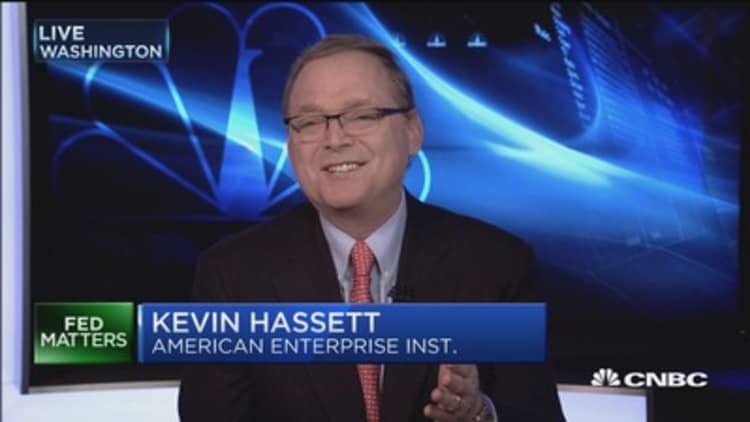
The Federal Reserve's indication this week that it expects three rate hikes in 2017 both moved markets and generated skepticism.
In particular, traders in the fed funds futures market believe the year ahead probably won't see more than two increases.
If 2016's action was any indicator, it probably is a wise idea to trust the market's interpretation.
At this time in 2015, Fed officials indicated that four hikes were likely this year, but traders remained doubtful and never priced in more than two. As the year wound to a close, the Federal Open Market Committee had approved just one — this week's move that took the funds rate to a still-low range of 0.5 percent to 0.75 percent.
Traders see the year ahead as likely having the same two hikes the Fed had predicted in September.
One in June, another in September — maybe
CME Group uses fed funds futures contracts, which traders purchase in anticipation of where they think the rate will be, to calculate probabilities for rate moves ahead.
As of Thursday morning, the results indicated the next rate rise will come in June, which has a 78.5 percent chance of a hike. From there, the probability of a September rate increase is slightly better than even, at close to 55 percent.
However, the chances of a third increase in December remain low, at just better than 46 percent.
Of course, fed futures trading is volatile and subject to a whole slew of variables likely to change significantly over the next 12 months. However, the market is treading cautiously when it comes to Fed expectations.
After all, while the change as indicated Wednesday raised some eyebrows, the central bank's thinking really hasn't changed that much when looked at across a broader time frame. In September, FOMC members indicated the likely funds rate at the end of 2017 would be 1.1 percent, but in June it was 1.6 percent. This week's estimate of 1.4 percent, then, essentially represents a compromise between the two forecasts.
"Put another way, the Federal Reserve has actually not changed its basis perspective on the trajectory for interest rates through 2017 in the back half of 2016," Nick Colas, chief market strategist at Convergex, said in a note. "A little nip here, a tiny tuck there. ... But (Wednesday's) change was far from a radical redo of its expectations."
Skepticism about the Fed's willingness to go for three hikes in 2017 extends beyond the Chicago futures desks.
Credibility in question
Some on Wall Street believe the Fed will be too data-dependent to move.
Citigroup analysts, specifically, think the central bank policymakers should be more attuned to what could be ahead for the economy, namely much more aggressive fiscal policies under President-elect Donald Trump that will drive inflation and require the Fed to play catch-up on rates.
"We expect central banks to be ahead of incoming data ... because of well-known variable transmission lags inherent with monetary policy," Citi said in a note. "The repeated failure of the Fed's forward guidance in anticipating their own behavior since the end of the Great Financial Crisis has reduced the FOMC's credibility considerably and put into question whether monetary policy is being formulated with a coherent and robust framework."
As inflation and the U.S. dollar rise, the Fed likely will rethink its expectations and hike just twice next year, the analysis said.
"We maintain our stance of projecting two (not three) rate increases for 2017, which is consistent with the continued skepticism in current market pricing of fed fund futures," Citi wrote. "We believe the drag from sustained high rates and the strong dollar may cause data realizations in early 2017 to be weaker than expected, and cause delays again in the normalization trajectory."


